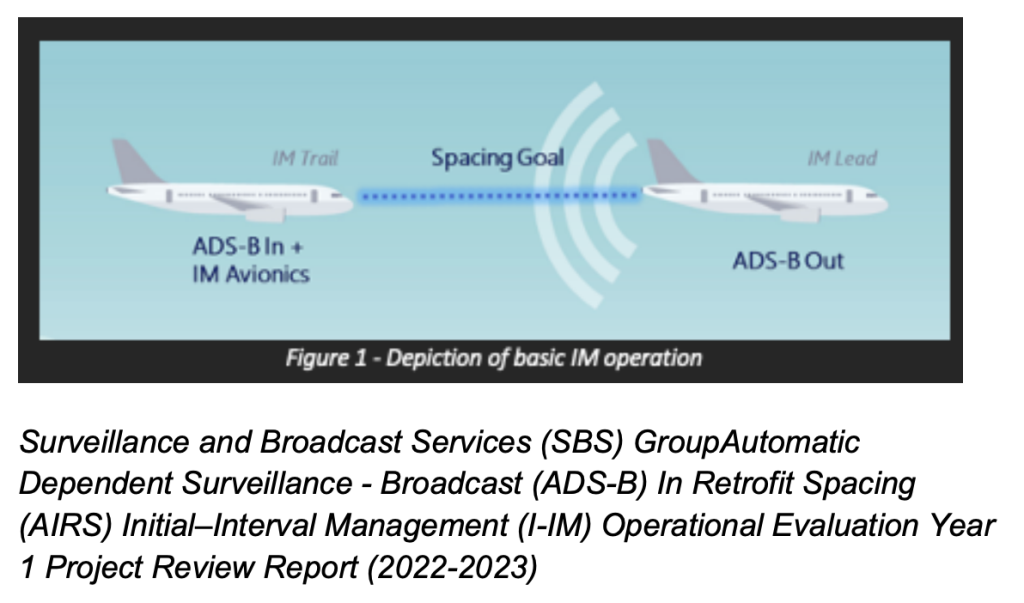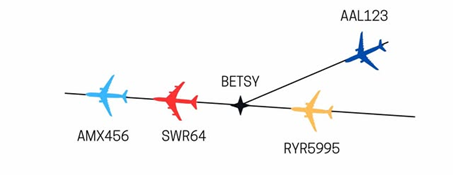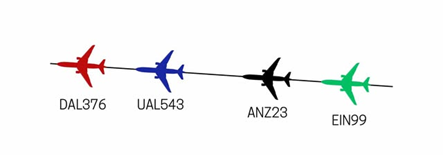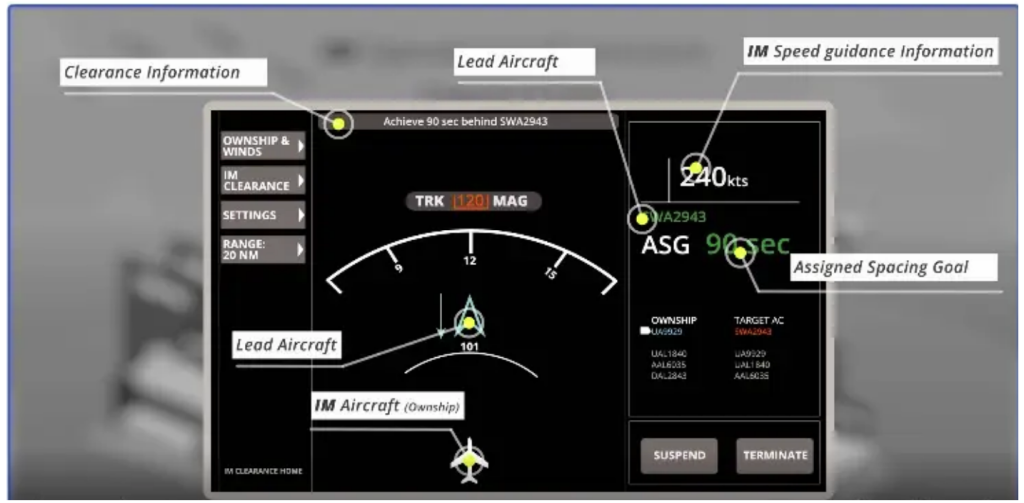64TH ANNUAL CONFERENCE, Abu Dhabi, 28 April – 2 May 2025WP No. 97A Study into Interval ManagementPresented by TOC |
| SUMMARY Interval Management (IM) is an Airborne Surveillance Application (ASA) and concept that provides new means of managing traffic flows and spacing of aircraft based on specific ground and airborne capabilities.IM is only used in the enroute environment. One of the biggest questions is what role does Air Traffic Control play in this operation. |
Introduction
1.1. As the demand for airline travel continues to climb, the pressure to increase capacity does the same. As airports only have so much concrete and limited availability for expansion, the push naturally slides to utilizing every bit of airspace, as efficiently as possible. Interval Management (IM) is being researched as one, possible solution.
1.1.1. IM is acknowledged and addressed in ICAO Manual on Airborne Surveillance Applications 9994, Chapter 4.
| 4.1 DESCRIPTION OF INTERVAL MANAGEMENT (IM) 4.1.1 IM is defined as the overall system that enables improved means for managing traffic flows and aircraft spacing. (ICAO, 2020) |
1.1.2. Trials have been conducted in the United States of America, during 2022-2024. These trials involved specially equipped A320/A321 and were conducted with Albuquerque Area Control Center (ZAB ARTCC). This will be discussed in more detail later in the paper. At the time of this paper, only the results from 2022-2023 were available. The results from 2023-2024 are projected to be released after May 2025.
1.1.3. IM is a controller technique that could be used in the spacing of aircraft. It is no different than issuing a crossing restriction or assigning a speed.
1.2. As the research and trials start to evolve towards this movement, there are a few issues to consider:
- Both aircraft (target aircraft and following aircraft) must be ADS-B equipped. The target aircraft must allow ADS-B Out and the following aircraft ADS-B In.
- At the time of the trials, there wasn’t any additional equipment provided to ATCO’s. This will be needed in the future to ensure that the ATCO is able to perform this function, by being able to differentiate which aircraft have the capability for this procedure.
- Training to utilize this procedure will be required for ATCO’s and pilots. How much is still unknown.
- Extra costs associated with both the equipment needed and the training must be considered. At this time, it is unclear who is willing to take on these expenses.
- Currently, there is no timeline for the implementation.
- Changing weather conditions need to be evaluated, in how this will affect this type of operation.
- Ensuring that ATCOs continue to be the responsible authority for separation.
- Concerns over Callsign misidentification. (IE: using 2 callsigns in 1 transmission.)
- IM may contribute to making operations in the air more efficient, but concerns remain about impacts to Runway Occupation Time and the bottleneck of gate availability.
Discussion
2.1. What is Interval Management?
2.1.1. Interval Management is an Airborne Surveillance Application (ASA) and provides new means of managing traffic flows and spacing of aircraft, based on specific ground and airborne capabilities. It allows the flight crew of a suitably equipped aircraft (so called “IM aircraft”) to achieve and/or maintain an assigned spacing in respect to a designated preceding aircraft, called the “target aircraft”. (IFALPA 21POS04 22 June 2021)

2.2. What equipment is required?
- Both aircraft need to be equipped with ADS-B.
- The target aircraft needs to be equipped with ADS-B Out and the following aircraft needs to be equipped with ADS-B in.
- The IM aircraft must be able to receive the target aircraft’s data via ADS-B In and display it on the Cockpit Display of Traffic Information (CDTI). This method was mandated per the trial.
- In the trials that took place in the United States, selected Airbus A320 aircraft were retrofitted with specialized CDTI equipment, labelled SafeRoute+. It provides pilots a forward field of view of surrounding aircraft up to 100 nautical miles using CDTI. (L3Harris)
2.3. The IM process
2.3.1. Pre-Initiation Phase
- The ATCO recognizes an IM aircraft and the lead aircraft.
- The controller must recognize the time or the distance-based Assigned Spacing Goal (ASG) and a crossing point, if applicable.
2.3.2. Initiation Phase
2.3.2.1. Once the ASG is identified, the “Initiation Phase” starts by having the ATCO assign an IM.
2.3.2.2. The IM consists of:
- A “target” and the specific separation requirement, either time or distance.
- When/where the crew must achieve it.
- The specific cancellation point, if they are unable to provide this.
- The crew receives the IM clearance and reads it back, to ensure accuracy. One concern that was identified was the possibility of misidentification/assignment by an aircraft. The possibility of using CPDLC was suggested, to prevent this.
Examples of Phraseology:
Cross clearance: “AAL123 cross BETSY at and maintain eight miles behind RYR5995”

Maintain clearance: “UAL543 Maintain eight miles behind DAL376”

PCP Amendment: “ACA469 cancel spacing at DRAKE resume normal speed.”
2.3.2.3. Upon receipt of the IM clearance, the flight crew must:
- Identify the target aircraft on the (CDTI).
- If the crew accepts the IM clearance, the target aircraft has to be selected in the Flight-deck Interval Management (FIM) avionics and the clearance parameters need to be inserted.
- The FIM avionics validate the feasibility and provide speed advisories which have to be complied with by the flight crew in order to meet the spacing goal. (IFALPA 21POS04 22 June 2021)

2.3.3. The “Execution Phase”
- The IM aircraft crew puts the new IM speed in and begins to implement the IM speed.
- As each new IM speed is presented to the crew, they must evaluate it and take into consideration the current aircraft configuration, environmental conditions, and airspace speed restrictions.
- ATC continues to monitor and is responsible for separation for all aircraft, including those involved in the IM operation, by using existing surveillance capabilities and procedures.
- If the controller requires spacing other than that provided by IM or is notified by the flight crew of an issue with the IM operation, the controller may cancel (formally or by way of speed instruction) or amend the IM operation.
- If the controller intends to provide vectors or re-routing to either the IM Aircraft or the Lead Aircraft, the controller instructs the flight crew of the IM Aircraft to cancel the IM operation. (FAA, 2024)
2.3.4. The “Cancellation Phase”
- If the ATCO or crew recognizes the need to cancel the IM clearance, this is executed via voice.
Phraseology Examples:
Descend Via to Cancel IM operation: “DAL241 [cancel spacing (optional)] descend via STAR to FL240”
IM rejection by Flight Crew: “Albuquerque Center AFR27 unable spacing [and reason (optional)]”
2.4. ATCO Involvement
- ATCOs were briefed and given documents to review, in a classroom setting. They were then trained in the dynamic simulator, for about 4 hours.
- Phraseology was changed with ATCO input 3-4 times, before it was fully accepted. This was to ensure the ease of the new phraseology, for the ATCO’s.
- Year 1 of the trials was focused on learning the new procedure. Year 2 was more focused on the execution of it.
2.5. ICAO Regulatory Considerations
Within ICAO Document 9994 specifications for regulations are detailed.
| 4.1 DESCRIPTION OF INTERVAL MANAGEMENT (IM) 4.7.2.1 General considerations 4.7.2.1.1 In States where air traffic services are provided based on IM capabilities, the requirements to receive those services should be clearly defined for operators. The States of the Operators and the States of the Registry should ensure that operators meet these requirements before operating such capabilities. 4.7.2.1.2 The States should publish any necessary requirements for granting operational approval to operate the IM capabilities. It is also useful to make available a State-level guidance document on how the approval can be obtained. 4.7.2.1.3 To ensure safety via consistent implementations of IM, State CAAs are highly encouraged to harmonize their conditions and requirements for approving operations of IM capabilities. The process and conditions for issuing such approval should be harmonized between States so that an approval issued by one State is automatically accepted by all other States unless explicitly forbidden. 4.7.2.1.4 Before conducting IM operations, operators should fulfill appropriate conditions and requirements published by relevant CAAs. (ICAO, 2020) |
2.6. Advantages and disadvantages of IM
2.6.1. Possible benefits from using IM in the enroute environment include:
- Maintaining efficient flight paths during high-density traffic periods.
- Reduced fuel burn, noise, and emissions when flights stay on their planned Performance Based Navigation (PBN) flight paths.
- Decreased system delays (FAA, 2023)
2.6.2. At the time of this paper, the expense of equipment for both ANSPs and users is currently not being addressed. It is unknown who will share the burden of new equipment and training for ATCO’s and pilots.
Conclusions
3.1. IM is another technique for controllers to use. It is a tool that would allow them an additional way of ensuring separation, while utilising airspace efficiently.
3.2. The consensus from the ATCO’s was that the concept was acceptable. The lack of automation, newness of the procedure and the additional phraseology added new challenges that would need to be addressed before full implementation.
3.3. There will need to be a high trust factor between ATCO’s and pilots, as there will be a slight lag between how the avionics in the aircraft perform and what the ATCO initially sees on the radar scope.
Recommendations
4.1. It is recommended that this is accepted as an information paper.
References
AVWeb. “‘interval Management’ Technology Set to Make Its Real-World Introduction.” AVweb, 2 Nov. 2022, http://www.avweb.com/aviation-news/interval-management-technology-set-to-make-its-real-world-introduction/.
FAA, (2023) “ADS-B in Interval Management.” ADS-B In Interval Management | Federal Aviation Administration, 12 Dec. 2023, http://www.faa.gov/air_traffic/technology/adsb/pilot/ima.
FAA, (2024) Surveillance and Broadcast Services (SBS) Group, and FAA. Automatic Dependent Surveillance – Broadcast (ADS-B) In Retrofit Spacing (AIRS) Initial–Interval Management (I-IM) Operational Evaluation Year 1 Project Review Report (2022-2023), 6 Sept. 2024. https://www.faa.gov/air_traffic/technology/adsb/quicklinks/AIRS%20I-IM%20Operational%20Evaluation%20Year%201%20Report_version%201.0.%20final%20for%20website.pdf.
ICAO. Manual on Airborne Surveillance Applications. 2nd ed., vol. 9994, International Civil Aviation Organization, 2020.
L3Harris. “SafeRoute+.” L3Harris® Fast. Forward., http://www.l3harris.com/all-capabilities/saferoute. Accessed 9 Jan. 2025.


